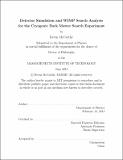Detector simulation and WIMP search analysis for the Cryogenic Dark Matter Search experiment
Author(s)
McCarthy, Keven (Kevin Ahmad)
DownloadFull printable version (64.45Mb)
Alternative title
Detector simulation and Weakly Interacting Massive Particles search analysis for the Cryogenic Dark Matter Search experiment
Other Contributors
Massachusetts Institute of Technology. Department of Physics.
Advisor
Enectalì Figueroa-Feliciano.
Terms of use
Metadata
Show full item recordAbstract
Astrophysical and cosmological measurements on the scales of galaxies, galaxy clusters, and the universe indicate that ~85% of the matter in the universe is composed of dark matter, made up of non-baryonic particles that interact with cross-sections on the weak scale or lower. Hypothetical Weakly Interacting Massive Particles, or WIMPs, represent a potential solution to the dark matter problem, and naturally arise in certain Standard Model extensions. The Cryogenic Dark Matter Search (CDMS) collaboration aims to detect the scattering of WIMP particles from nuclei in terrestrial detectors. Germanium and silicon particle detectors are deployed in the Soudan Underground Laboratory in Minnesota. These detectors are instrumented with phonon and ionization sensors, which allows for discrimination against electromagnetic backgrounds, which strike the detector at rates orders of magnitude higher than the expected WIMP signal. This dissertation presents the development of numerical models of the physics of the CDMS detectors, implemented in a computational package collectively known as the CDMS Detector Monte Carlo (DMC). After substantial validation of the models against data, the DMC is used to investigate potential backgrounds to the next iteration of the CDMS experiment, known as SuperCDMS. Finally, an investigation of using the DMC in a reverse Monte Carlo analysis of WIMP search data is presented. 140.23 kg-days of WIMP search data from the silicon detectors in the CDMSII experiment is also analyzed. The resulting upper limits on the WIMP-nucleon crosssection are higher than those published by other experiments at all WIMP masses, and the lowest limit on the WIMP-nucleon cross-section is 1.07*10-42 cm2 at a mass of 60 GeV/c2. These results do provide new and interesting constraints at WIMP masses <40 GeV/c2 and cross sections from 10-42 - 10-39 cm2, a region in which some WIMP search experiments have claimed evidence for a WIMP signal, which other experiments claim to have ruled out.
Description
Thesis (Ph. D.)--Massachusetts Institute of Technology, Dept. of Physics, 2013. This electronic version was submitted by the student author. The certified thesis is available in the Institute Archives and Special Collections. Cataloged from student-submitted PDF version of thesis. Includes bibliographical references (pages 370-388).
Date issued
2013Department
Massachusetts Institute of Technology. Department of PhysicsPublisher
Massachusetts Institute of Technology
Keywords
Physics.